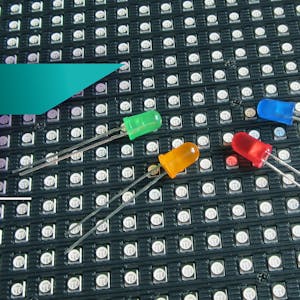Discover the intricate world of LED signs and displays with this comprehensive course. From small fixed-pattern signs to large LED screens, you'll delve into the inner workings, fabrication, and microcontroller programming. Gain a deep understanding of electronic concepts, microcontroller hardware, and C programming. Throughout the course, you'll have the opportunity to program remote signs and displays and witness the results via video, encouraging hands-on practice. You'll also be guided through creating your own signs and displays, progressively advancing in complexity.
Key topics covered include understanding LED signs and displays, circuits, microcontrollers, diode junctions, transistors, programming in C-Arduino, VHDL, sequential logic circuits, PWM, LED characteristics, color, interrupts, timers, addressable LED ribbons, FPGA, and more.
Certificate Available ✔
Get Started / More Info
This comprehensive course spans six weeks, covering various aspects of LED signs and displays, including electronic concepts, microcontroller programming, and practical applications.
This module introduces the course and covers a range of topics such as understanding LED signs and displays, electric circuits, microcontrollers, diode junctions, and combinational logic circuits. It also provides an overview of the learning objectives and course evaluation.
Week 1 delves into the physical principles of diode junctions, transistors, C-Arduino programming, fixed-pattern signs, and an introduction to VHDL. Participants engage in remote experiences, including the creation of a chaser light.
During Week 2, participants explore sequential logic circuits, input/output, pulse-width modulation (PWM), time-division multiplexing, and 7-segment 4-digit displays. The remote experience involves creating a 7-segment 4-digit display.
Week 3 focuses on matrix displays, binary-coded modulation, permanent memories, counter sequencers, sequential circuits in VHDL, and LED properties. Participants get hands-on experience with an 8x16 matrix display.
Week 4 delves into topics such as interruptions, timers, addressable LED ribbons, multiplexed matrix displays, programmable logic circuits (FPGA), and gamma correction. Remote experiences include creating a 16x16 matrix display and using LED ribbons on STM32.
During Week 5, participants explore direct memory access, real-time clocks, remote control, specialized interpreted languages, controlling displays with an FPGA, and video and LED walls. Remote experiences include working with Nucleo STM32 and creating a 32x32 display on STM32.
Week 6 covers advanced topics such as direct memory access, real-time clocks, remote control, specialized interpreted languages, controlling displays with an FPGA, and video and LED walls. Participants engage in remote experiences, including working with Nucleo STM32 and creating a 32x32 display on STM32.
Electrónica en cápsulas ofrece 3 cursos de electrónica analógica de nivel universitario. Aprende sobre fundamentos, diodos, transistores, y aplicaciones interesantes...
This course delves deep into semiconductor physics, pn junctions, and electronic devices, providing essential knowledge for understanding integrated circuits technology....
Introduction to Semiconductor Devices 2 provides a comprehensive understanding of semiconductor devices, covering Metal-Semiconductor Contact, MOSFETs, CMOS, Memory,...
This course provides in-depth training on design-oriented analysis techniques for switching power converters, focusing on the Extra Element Theorem and N-Extra Element...